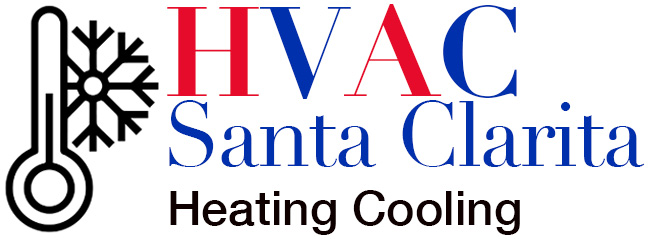Gas furnace parts work collectively to ensure your house remains warm all winter. And just like your body, if one or several parts have issues, the end goal will not be well-executed. In a gas furnace, if one part has problems, you can expect to spend a lot of money on gas furnace repair.
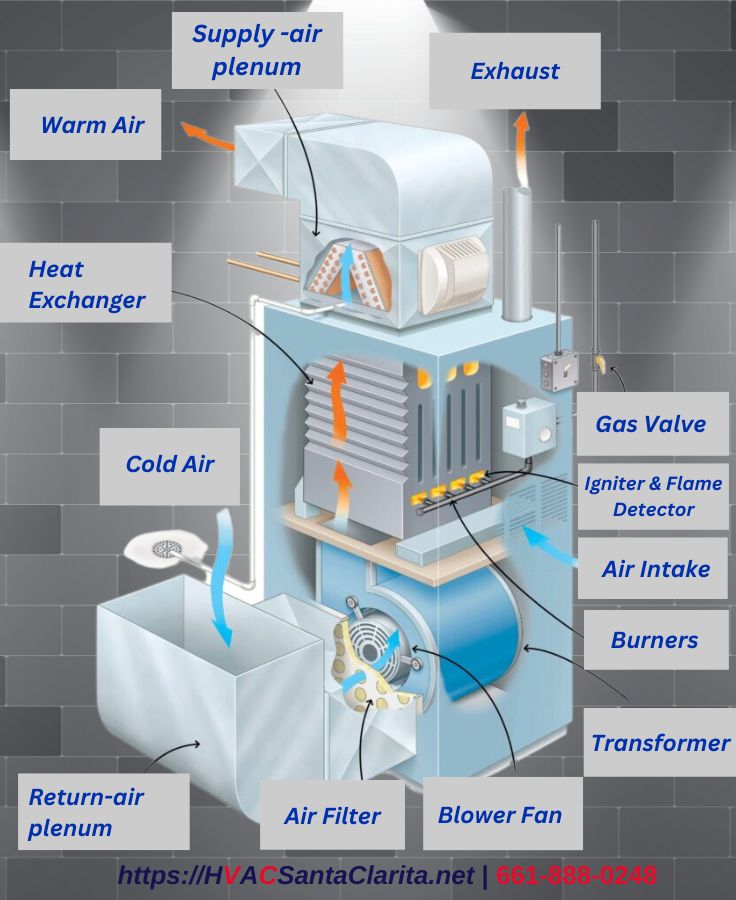
To ensure optimal heating (and avoid lookup of “heating system repair near me“), all the furnace parts must be in excellent working condition. You need understand how they collaborate to give excellent results. Additionally, you need to know how to detect a problem, how to troubleshoot it, and when to call gas furnace installers.
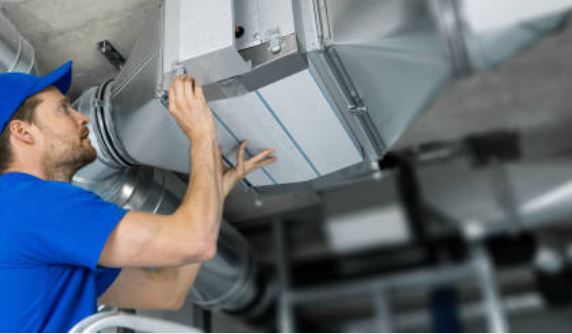
call 661-888-0248
Contact us 24/7 for HVAC services!
Here at HVAC Santa Clarita, we understand how costly gas furnace replacement can be. This is why we go above and beyond to ensure our clients’ gas furnace parts are all optimally functional.
Looking to go deeper into gas furnace parts? Read on.
Gas Furnace Burner
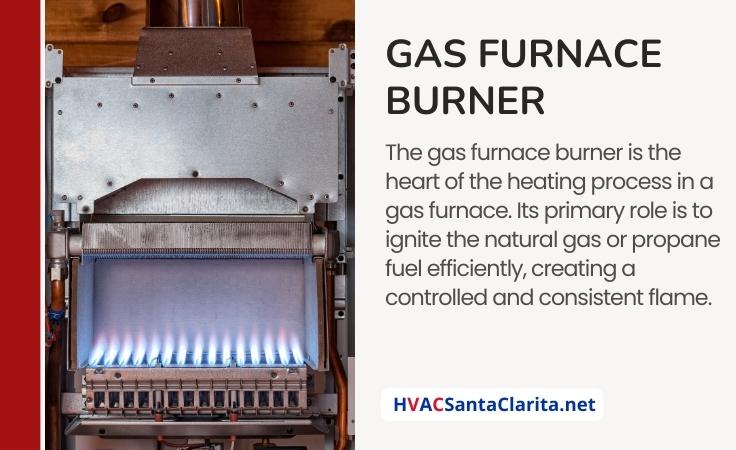
The gas furnace burner is the heart of the heating process in a gas furnace. Its primary role is to ignite the natural gas or propane fuel efficiently, creating a controlled and consistent flame. This flame is the initial step in generating heat to warm your home during heating seasons.
The burner precisely blends the incoming gas with air to achieve optimal combustion. This balance ensures the fuel is burned cleanly and efficiently, minimizing energy waste and reducing emissions.
Burners can come in various designs, including in-shot and ribbon burners, each with unique characteristics and advantages.
Inducer Motor

The gas furnace inducer motor, or the draft inducer motor, is critical to your gas furnace’s ventilation system. It is instrumental in removing combustion gasses and ensuring proper airflow within the furnace.
Maintenance of the inducer motor typically involves periodic cleaning and lubrication as needed. It’s essential to keep the motor’s debris-free and ensure it operates smoothly. Consult a qualified HVAC technician for inspection and repairs if you encounter any issues with the inducer motor.
Gas Valve
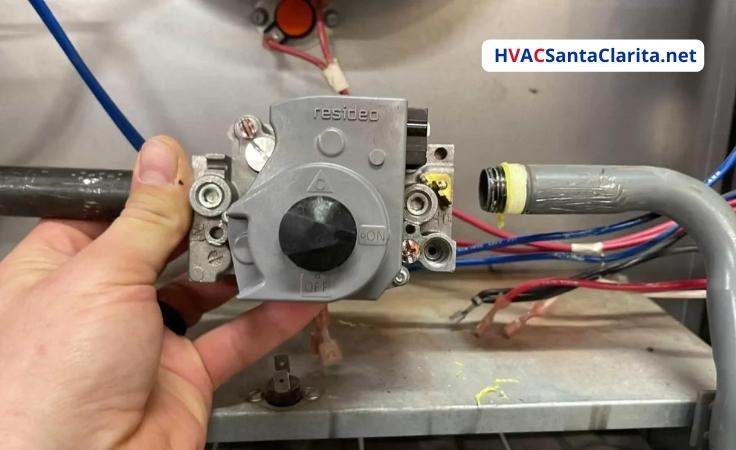
The furnace gas valve regulates the flow of natural gas or propane into your furnace’s combustion chamber. The combustion chamber is where the gas is burned to produce heat. Think of the gas valve as the gatekeeper of your heating system. It allows just the right amount of fuel to enter the burner for the efficient generation of warmth.
One of its primary functions is to respond to signals from the thermostat. When your home’s temperature drops below the desired setting, the thermostat transfers a signal to the gas valve, indicating that it’s time to open and allow fuel to flow to the burner.
Conversely, when the desired temperature is reached, the valve closes, halting the gas flow and stopping the heating process.
The furnace gas valve has safety features to ensure reliable and secure operation. For instance, it includes a safety shutoff mechanism that can swiftly close the valve if it detects any irregularities, such as a malfunctioning thermostat or a problem with the burner. This built-in safety measure helps prevent potential hazards like gas leaks.
Furthermore, modern gas valves often incorporate electronic controls, allowing for precise gas flow modulation. This modulation enables the furnace to adjust its heat output based on the specific heating needs of your home, contributing to energy efficiency and consistent comfort.
Heat Exchanger
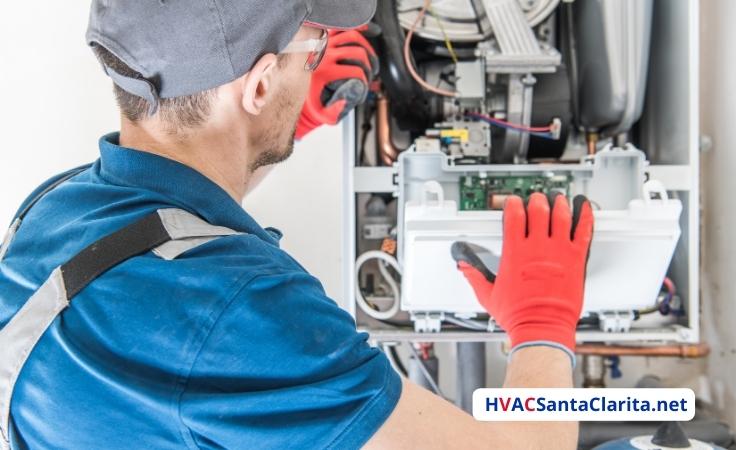
The gas furnace heat exchanger is responsible for transferring heat from the burner to the air before it is circulated throughout your home.
It is composed of a series of metal tubes or coils heated by the burner’s flame.
When the burner ignites, it produces an intense, controlled flame within the heat exchanger. This flame heats the metal surface of the exchanger to a high temperature. Simultaneously, the blower motor draws in cool air from your home’s interior and passes it over the heated exchanger.
As the cool air passes over the hot metal surface, it picks up the heat, causing the air to become warm. This newly heated air is then distributed through the ductwork and vents to every room in your house, raising the indoor temperature and providing comfort during cold weather.
Additionally, heat exchangers play a role in ensuring your safety. It acts as a barrier between the combustion process and the air you breathe. It ensures that the potentially harmful combustion gasses, including carbon monoxide, are contained within the sealed combustion chamber, preventing their release into your living spaces.
Regular maintenance and heat exchanger inspection are essential for safety and efficiency. Over time, wear and tear can result in cracks or damage in the exchanger. These issues can allow combustion gasses to escape into your home, posing severe health risks.
Blower Motor
The gas furnace blower motor circulates warm air through your home’s ductwork. It can have variable speeds for efficient and quiet operation.
It is the workhorse of your gas furnace, responsible for circulating warm air throughout your home. This motor-driven fan plays a pivotal role in ensuring that the heat generated by the furnace reaches every room, providing consistent comfort during cold months.
Here’s how it operates: after the heat exchanger has warmed the air, the blower motor activates. It draws in the heated air from the heat exchanger and pushes it through the ductwork system, distributed to various vents and rooms in your house. The result is a steady flow of warm air that raises the indoor temperature to your desired level.
Regular maintenance of the blower motor is essential to keep your furnace running smoothly. This includes cleaning or replacing air filters, ensuring proper lubrication, and checking for any signs of wear or damage. Neglecting HVAC maintenance can lead to reduced efficiency and increased energy consumption.
Thermostat

The thermostat is your direct interface with your heating system, enabling you to set and maintain your desired indoor temperature. It serves as the control hub for your furnace, allowing you to adjust heating settings based on your comfort preferences.
Thermostats contain a temperature sensor that constantly monitors the air temperature in your home. When the temperature falls below the set point (the desired temperature you’ve selected), the thermostat signals your heating system to start.
Other thermostat features:
- User Interface: Most thermostats feature a user-friendly interface, often with a digital display, buttons, or a touchscreen to help you adjust settings.
- Heating Mode Selection: Depending on the type of thermostat you have, you can select various heating modes, including “heat,” “cool,” “fan-only,” or “auto”.
- Programming and Scheduling: Programmable thermostats offer programmable features, allowing you to explore energy-efficient temperature management by automatically adjusting the heating when you’re away or asleep.
- Remote Access: Modern smart thermostats take temperature control to the next level, e.g., through the home’s Wi-Fi network, allowing you to adjust settings remotely using an app or voice commands.
Thermostats are crucial in optimizing energy efficiency and comfort in your home. You can cut energy consumption and lower utility bills by setting your thermostat to correspond to your heating needs. Smart thermostats, in particular, offer advanced features like learning your schedule and providing energy usage insights(1).
Regularly checking and calibrating your thermostat and changing its batteries, if necessary, ensures accurate temperature control. In the event of thermostat malfunctions or programming issues, it’s advisable to seek assistance from an HVAC tech to diagnose and resolve the problem.
Control Board

The gas furnace control board serves as the brain of your gas furnace, coordinating the various functions and components to ensure efficient heating and temperature control. Think of it as the command center that interprets signals from your thermostat and sensors and then instructs the furnace on responding.
Here’s what the control board does:
- Thermostat Communication: When your thermostat detects a temperature change, it sends a signal to the control board, which interprets this signal and directs the furnace to activate the burner, blower motor, or other components to achieve the desired indoor temperature.
- Safety Monitoring: The control board monitors various safety devices within the furnace. It can shut down the furnace to prevent unsafe conditions if it detects any issues, such as a malfunctioning pressure switch or flame sensor.
- Sequencing: the control board decides when to ignite the burner, activate the blower, and shut off the furnace to maintain efficient and safe heating.
- Diagnostic Capabilities: If your furnace has a problem, the control board can provide error codes, making it easier for HVAC technicians to identify and resolve issues quickly.
- Efficiency Control: Some control boards can modulate the furnace’s output, allowing it to operate at various capacities. This modulating capability helps optimize energy usage and maintain a consistent indoor temperature.
Limit Switch
The gas furnace limit switch is a safety device that continuously monitors the temperature of the furnace. If the furnace’s internal temperature rises above a safe threshold, it triggers the switch. It then shuts down the burner and blower to prevent overheating and potential hazards.
This critical safety mechanism protects your heating system and your home, ensuring that the furnace operates within safe temperature limits at all times.
Gas Furnace Transformer

The gas furnace transformer is a small but essential component that plays a crucial role in the furnace’s electrical system. It converts the standard household voltage to a lower voltage needed for safe and efficient operation. This lower voltage powers various control components, such as the thermostat and relays, ensuring that the furnace operates as intended. While compact, the transformer’s function is vital, and its proper maintenance is essential for the furnace’s electrical and overall performance.
Fuse

Gas furnace fuse serves as a critical safety device. They protect the furnace’s electrical components from damage by interrupting the electrical circuit when an overload or short circuit occurs. This interruption prevents excessive current from reaching sensitive parts like the control board or blower motor, reducing the risk of electrical fires or equipment damage. Fuses play a vital role in maintaining safe and efficient furnace operation.
Regular maintenance includes checking and replacing blown fuses when necessary. If repeated fuse failures occur, it’s crucial to have an HVAC technician investigate and resolve underlying electrical issues, whether you have a gas or electric furnace. This will ensure continued furnace safety and performance.
Other Minor Gas Furnace Parts
- Gas Line and Supply: This includes the gas line that delivers natural gas or propane to the furnace
- Pressure Switch: A pressure switch ensures adequate airflow for safe combustion. If airflow is insufficient, it can shut down the furnace to prevent the buildup of dangerous gasses.
- Igniter: In modern furnaces, an igniter starts the combustion process. It’s often a hot surface igniter or a spark igniter.
- Flame Sensor: It detects the presence of a flame. If it doesn’t detect a flame when the burner is supposed to be on, it shuts off the gas supply for safety.
FAQ
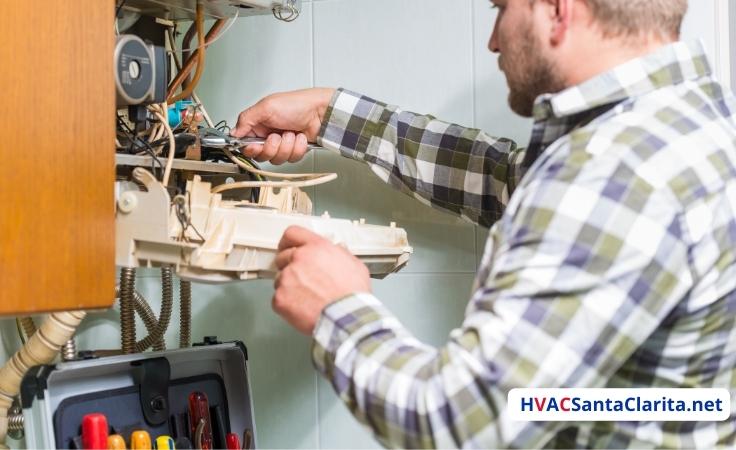
What is the most expensive part of a gas furnace to replace?
The most expensive part of a gas furnace to replace is typically the heat exchanger. This is because it involves extensive labor and also because of its integral role in heat transfer.
What are the basic components of a furnace?
Essential components of a furnace include the burner, which ignites fuel; the heat exchanger, which transfers heat; the blower motor, thermostat, gas valve, and control board, all which coordinate for the success of heating operations.
Final Words
In conclusion, understanding the vital components of a gas furnace or electrical is crucial for homeowners, as it empowers them to make informed decisions about maintenance and repairs. Components like the heat exchanger, blower motor, thermostat, and control board all work together to ensure efficient heating and safety.
Regular HVAC maintenance, such as cleaning and replacing filters, can help extend the lifespan of these components and maintain optimal furnace performance. Additionally, recognizing the importance of safety devices like limit switches and fuses reinforces the significance of furnace safety. Overall, a well-maintained furnace with its various components functioning correctly ensures comfort, energy efficiency, and peace of mind during the colder months.
In wrapping up, every part of a gas furnace is crucial for its optimal function. Keeping up with maintenance is vital for efficiency and longevity. If you’re ever in need of assistance or considering an upgrade, don’t hesitate to seek a professional for your heating system installation to ensure peak performance and enduring warmth.

call 661-888-0248
Contact us 24/7 for HVAC services!
Our Address is
HVAC Santa Clarita
26893 Bouquet Canyon Rd
Santa Clarita CA 91350
Opening hours
Monday 8 am – 8 pm
Tuesday 8 am – 8 pm
Wednesday 8 am – 8 pm
Thursday 8 am – 8 pm
Friday 8 am – 8 pm
Saturday 8 am – 8 pm
Sunday 9 am – 5 pm
Also, Read Heat Pump vs Gas Furnace >>>
